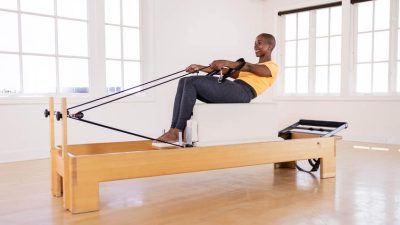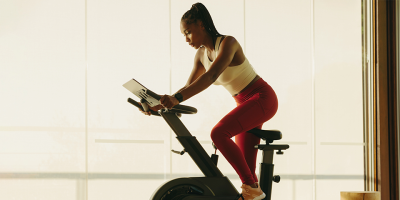
Every time we open up Tiktok or Instagram, we scroll past soft wellness girlies — women touting the trend toward slower fitness, which includes everything from hot girl walks to soft hiking to yin yoga to Pilates.
But, no less than five minutes later, we’re hit with nearly the parallel opposite on our feed — muscle mommies. Think women (moms or childfree!) showing off their gains, lifting routines, and daily macro counts.
If you’re like us, this could leave you wondering…what’s the best option for me? Should I be slowing down my fitness routine or should I be hitting it hard at the gym and building muscle daily?
Let’s dive into both approaches.
The skinny on ‘soft wellness’
Soft isn’t necessarily a word that comes to mind when you traditionally think about fitness. But, since 2020, “soft wellness” has been on the rise as people craved a gentler approach amidst uncertainty and burnout. As a result, they turned to walks, low-impact pilates and barre classes, mobility routines, pickleball, and most recently, soft hiking, which is all about slowing down and strolling through nature.
Fun, functional, and approachable
While you may sweat less with anything in the soft and slow category, these activities allow you to have fun, feel good in functional movements and access a fitness routine at any level (three cheers for accessibility!). A majority of these workouts often involve friends or family, so you have the added benefit of community too!
The benefits
Soft movements don’t just feel good — they are beneficial for both your body and your mind.
Since many of your movements are slowed down in these workouts, you are encouraged to practice mindfulness. You can tap into how specific muscles and joint receptors feel as you move, helping you get more in tune with your body. This also allows you to pay attention to form and can encourage you to move in the proper way to maintain long-term joint and muscle health.
Not to mention, workouts like Pilates and yoga encourage mobility and stability training, which help you move freely with more range of motion and support joints during movement, respectively.
With all of this in mind, soft wellness workouts aren’t going to give you the same fitness and performance results you may get from more intense workouts. But, they deliver overall holistic health, mental health, and stress management results.
No pain, no gain
Shifting gears, ‘muscle mommies’ are more in line with a traditional view of fitness. This trend is all about celebrating building muscle, leaning out, and exercising to your full potential. Since muscular strength carries you through life, it’s no surprise that even amidst the soft wellness trend, “strength training” saw an uptick in Google searches over the last year.
The benefits
High-intensity exercise and strength training are known to boost your metabolism, improve body composition, boost cognitive function, improve heart and brain health, and increase bone strength, which is key as you age.
Beyond the direct physical benefits, heavy lifts, gains, and high-intensity workouts build confidence. These workouts are ways to practice overcoming challenges, working towards a goal, and appreciating your body’s strength. It’s a method of building self-efficacy, the belief that you can succeed.
Plus, research has shown that there’s a link between strength training and positive body image. And, we won’t lie, it can be empowering to know you are in the main weight room of a gym!
But is it the best way to workout?
But, the trend towards lifting heavy and leaning out has its drawbacks too. Too much of a good thing can be bad!
HIIT spikes cortisol levels, so if you overdo it, you can increase the hormone over long periods and feel the side effects, including digestive issues, bloating, and weight gain. The spike in cortisol can also cause lasting anxiety outside of your workouts, which can impact day-to-day life and your sleep quality.
Overtraining at a high level can also set you up for muscle and joint injury, with the potential for long-term damage.
What is YOUR best way to workout?
So, how do you know which of these options is best for you?
First and foremost, explore your motivations every few months. Are you looking to maintain overall wellness and support your mental and emotional well-being, as well as the longevity of your physical health? Or, are you looking to adjust your body composition and put on muscle?
This reflective exercise can help guide you to what form of working out may be best for you at this time.
Secondly, we’re all about trial and error and exploring each in a balanced approach. Test out a few soft wellness movements and then hit it hard with an extra sweaty workout session. After testing both out a few times, ask yourself a few questions. Which feels better to you and your body? Is this the right balance? Am I actually interested in doing this? You’re less likely to miss your daily movement if you actually want to do it.
Variety is the spice of life
While you may favor slower workouts or more intense sweat sessions, balance is key.
Varying your workouts can help you avoid overuse injuries and encourages you to work all muscle types. Gym sessions may lend themselves to bigger muscle groups, while mobility training or other low-impact options can help you strengthen accessory and stabilization muscles, as well as build your cardiovascular health (especially on long walks or hikes!). Plus, the variety can help you stay interested and engaged, which inspires you to move and stay mentally and physically healthy.
Right now, we love a mix of both trends and are listening to what our body wants and craves at the moment!
How do you balance your workouts? Do you tend to favor slowness or intensity?






